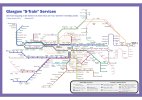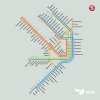It all sounds fine in theory, but... it's just theory unless anyone is going to come up with some UK examples
I can see the logic in a shuttle service from E-F-G (based on the example above), I'd find it useful to have more choice of services so I didn't need to go into the city centre, I'm not against any of this - it's just that it's all very abstract on the thread, nobody is even suggesting any UK routes that they'd want to link with an orbital service
Absolutely. I mean, the concept isn't new or radical. Going back to Bristol, the main radial routes (M-F headway in brackets) are:
10 Avonmouth - Westbury - Southmead Hospital - Bristol Parkway - Thornbury (60)
11 Avonmouth - Shirehampton - Southmead Hospital - Bristol Parkway (60)
3 Cribbs Causeway - Henbury - Avonmouth - Shirehampton then continues to city centre (30)
4 Cribbs Causeway - Henbury - Lawrence Weston - Shirehampton then continues to city centre (30)
17 Southmead Hospital - Fishponds - Kingswood (30) - Keynsham (60)
19 Bath - Kingswood - UWE - Bristol Parkway - Cribbs Causeway (60)
12 Bristol Parkway - Cribbs Causeway - Severn Beach (60)
622 Yate - Thornbury - Cribbs Causeway (60)
96 Brislington - Broadwalk - Hengrove Park (120)
505 Long Ashton - Clifton - Southmead Hospital (30)
511 Stockwood - Hengrove Park - Hartcliffe (60)
55 Hengrove Park - Hartcliffe - Bristol Airport
I think that with the exception of the 3/4, and possibly the 17 and maybe bits of the 19, all the rest are tendered by local authorities. You see many common points where they do intersect with rail (Bristol Parkway) or major trunk bus routes. However, this is almost a subsistence network and it's under threat.
Getting back to Glasgow, you will see similar routes but I just fail to see how the funds will enable it to happen, and that's the issue. There's clearly a need, and it's desirable on many levels. However, when you've major routes now under threat of going to 15 min headways and losing the turn up and travel concept, I'm not optimistic about similar headways on these lesser, radial routes.
That's all very true and to imagine that merely integrating transport will resolve these issues over night is of course laughable. That said, perhaps a combination of:
1) Progressively moving away from car-centric policies and planning principles.
2) Increasing funding streams for higher frequencies and new projects (heavy rail extensions or capacity upgrades, light-rail, BRT etc.). Public transport needs to become a national priority. I don't how that would be achieved, but it's worth dreaming about (one thing is clear, the SNP needs a rocket up their a***).
3) Integrating all public transport, especially in terms of ticketing, first on a regional basis, then perhaps across the whole of Scotland.
At that point, Greater Glasgow's public transport network might actually start to look rather respectable. There's still a lot do and many deep-seated issues remain, some of which are tricky to reverse, but I suppose in the UK there are still many cities that offer a worse foundation to build upon than Glasgow, so I choose to remain optimistic.
Indeed, at least Strathclyde has some sort of base and they can do things to really even things up a bit. However, I'm not certain that there's the political will to do it sadly.




